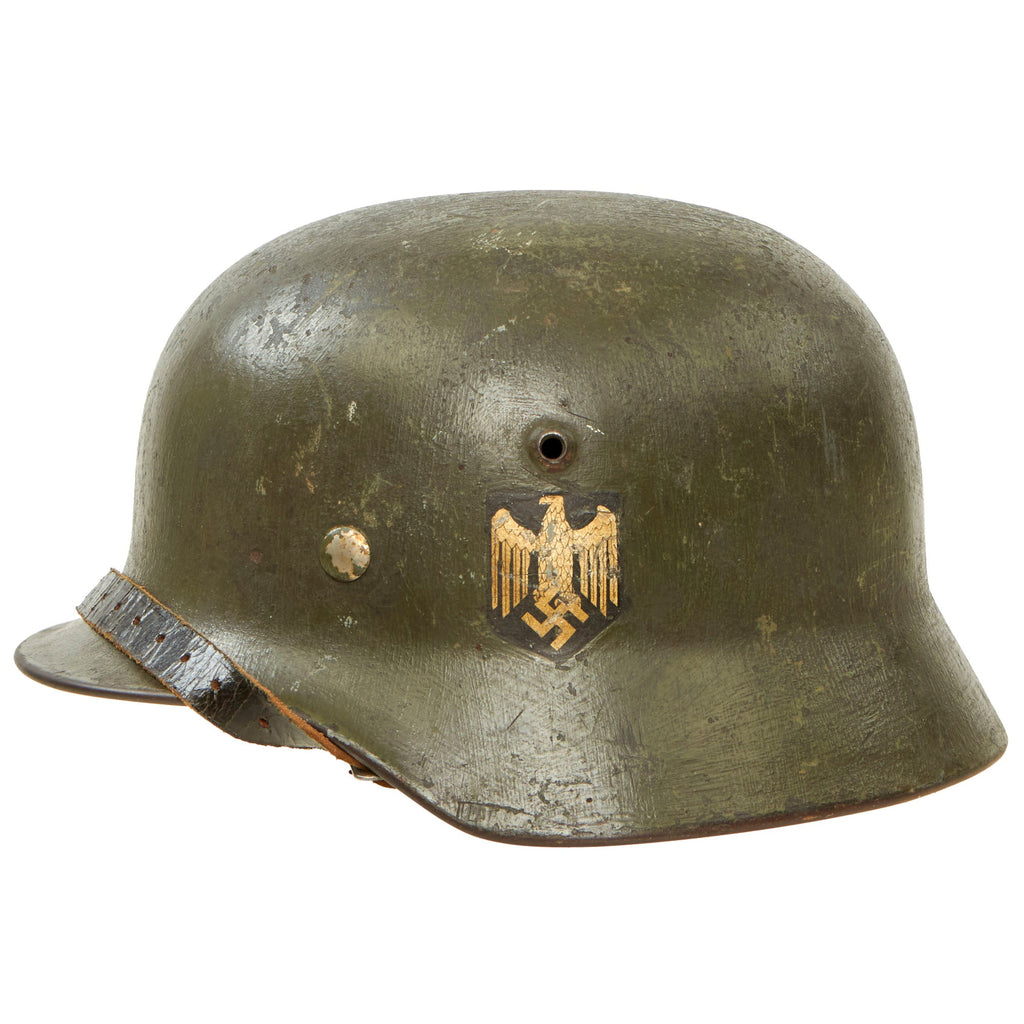Item Description
Original Item: Only One Available. This is a lovely example of a German WWII M35 helmet, as issued to the Heer (Army), with very desirable "Double Decals". This stamped sheet steel construction helmet definitely looks to have seen long service during the war, and was originally painted with early war Apfel-grün (apple green) paint. It was then field repainted with a slightly lighter green color on the exterior only. You can even see the brush pattern! The Heer Army decal was covered during this, so it was not painted over. The National Colors however was painted over, but the helmet definitely saw additional service, and over time the paint wore away, so now portions can be seen where the paint is missing. This has worn the paint off around the bottom rim, one of the first places for it to wear away.
The use of the second decal was discontinued in 1940, and in 1943 it was ordered that helmets with the national colors have them removed. The decal on this helmet however escaped that fate, so it still has both decals. The National Colors is only partly visible, but the Heer Eagle is actually retained at about 75%, and looks great, with a lovely yellowed color to the enamel! Definitely lots of history here!
The reverse, interior, neck guard apron is serial number stamped 3175 and the interior, left side, apron has the stamped manufacturer's code and size, Q64 indicating that it was manufactured by F.W. Quist G.m.b.H. in the German city of Esslingen. Size 64 is a nice smaller size that can accommodate liners from 56cm to 57cm or US 7 to 7 1/8. Size 64 shells are harder to find and are therefore more valuable to a collector.
All three liner retaining pins are intact, however they look to be nickel plated, which has caused most of the paint to flake off all three. The interior of the helmet still has the original M31 leather liner, with all eight of the original fingers intact, and an intact top tie string. The leather is still soft and supple, and has a lovely chestnut brown color, showing some splitting around the edge, and is marked with the size 57 on one of the fingers. The liner band is aluminum, with square aluminum chin strap loops attached to reinforced sides. This is the last pattern before the move to galvanized steel bands, as aluminum was scarce. The left exterior of the liner band is marked 64 n.A / 57, indicating that it is a size 57 liner for a size 64 shell. The right side displays the full manufacture information, as well as a date:
SCHUBERTH - WERK K.-G.
D.R.P.
1939
BRAUNSCHWEIG
This is exactly the right period and type of liner for this very early helmet.
The attached chin strap features galvanized steel hardware, though only one of the studs is steel, while the other is early war aluminum. It is in very good condition, still supple, with most of the wear only in the finish. The end of the longer portion with is maker marked dla / 40, for 1940 manufacture by Karl Barth of Waldbröhl / Rheinland, a known maker of all types of leatherware during the WWII Period.
Overall a very nice 100% genuine M35 Double Decal Heer Army helmet with loads of history! It looks great, with a fantastic patina! This is an item that will only continue to appreciate in value over time!
The first "modern" steel helmets were introduced by the French army in early 1915 and were shortly followed by the British army later that year. With plans on the drawing board, experimental helmets in the field, ("Gaede" helmet), and some captured French and British helmets the German army began tests for their own steel helmet at the Kummersdorf Proving Grounds in November, and in the field in December 1915. An acceptable pattern was developed and approved and production began at Eisen-und Hüttenwerke, AG Thale/Harz, (Iron and Foundry Works), in the spring of 1916.
These first modern M16 helmets evolved into the M18 helmets by the end of WWI. The M16 and M18 helmets remained in usage through-out the Weimar Reichswehr, (National Defence Force, Circa 1919-1933), era and on into the early years of the Third Reich until the development of the smaller, lighter M35 style helmet in June 1935.
In 1934 tests began on an improved Stahlhelm, whose design was a development of World War I models. The Eisenhüttenwerke company of Thale carried out prototype design and testing, with Dr. Friedrich Schwerd once again taking a hand.
The new helmet was pressed from sheets of molybdenum steel in several stages. The size of the flared visor and skirt was reduced, and the large projecting lugs for the obsolete armor shield were eliminated. The ventilator holes were retained, but were set in smaller hollow rivets mounted to the helmet's shell. The edges of the shell were rolled over, creating a smooth edge along the helmet. Finally, a completely new leather suspension, or liner, was incorporated that greatly improved the helmet's safety, adjustability, and comfort for each wearer. These improvements made the new M1935 helmet lighter, more compact, and more comfortable to wear than the previous designs.
The Army's Supreme Command officially accepted the new helmet on June 25, 1935 and it was intended to replace all other helmets in service.
More than 1 million M1935 helmets were manufactured in the first two years after its introduction, and millions more were produced until 1940 when the basic design and production methods were changed.
- This product is available for international shipping. Shipping not available to: Australia, France, or Germany
- Due to legal restrictions this item cannot be shipped to Australia, France or Germany. This is not a comprehensive list and other countries may be added in the future.
- Not eligible for payment with Paypal or Amazon



















